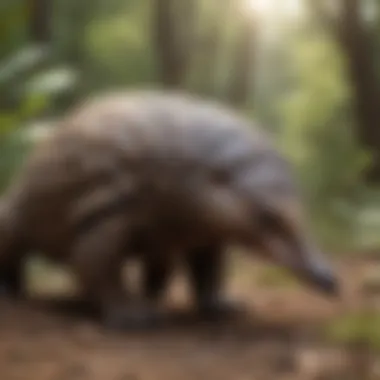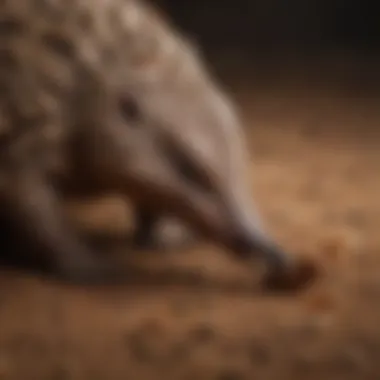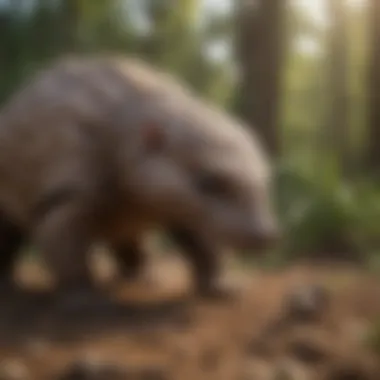Exploring the Dietary Habits of Pangolins


Nature Topic Overview
Pangolins are truly unique creatures. When we think about them, many people picture scaly animals curling up into a ball, right? But there's so much more beneath their tough scales! This section dives into their fascinating diet, which mostly consists of ants and termites. This special eating habit not only sets them apart but also plays an important role in the ecosystem. When pangolins munch away at termite mounds, they help to control the pest population, making them essential workers of nature.
The Role of Pangolins in Nature
These critters are like nature's vacuum cleaners. They have long, sticky tongues that can stretch out to gather up to 16 inches! Imagine that! Their strong, clawed feet help them dig deep into the ground or tear open ant hills. And, oh boy, they can really tear things up! This is all part of their eating technique. Without pangolins, the balance of their habitats would be thrown off, potentially leading to more pests and fewer healthy ecosystems. They may be small in size, but their impact is big.
Fun Facts and Trivia
- Did you know there are eight species of pangolins? Each one is unique, but they all share in that tasty ant diet.
- Pangolins are the only mammals covered in scales! Their scales are made of keratin, the same thing that makes up our hair and nails.
- Their skin is super tough, almost like armor, which helps protect them from predators.
- Pangolins can eat up to 70 million insects in a year! That's like a family of four eating 1,000 pizzas in one go!
This wild nutrient-rich diet means they are constantly leading a life of foraging and discovery, keeping their teeth and tongues busy.
Wildlife Explorations
Pangolins live in different habitats, from forests to grasslands. Each species has adapted to its own environment. This means that some pangolins might dig deep in the rainy jungles, while others might try their luck in arid deserts.
Connected Species
- Ants: They are plentiful and form a significant part of the pangolin's diet. Across the globe, there are about 12,000 ant species.
- Termites: These little guys might seem like pests to us, but for pangolins, they are delicious! Termites are known to be abundant in tropical areas.
Did you know that pangolins are also important to certain bird species? Birds like the African Grey Hornbill often raid pangolin burrows for leftover insects. So, it's a chain of life, all connected!
Environmental Awareness
As we learn more about pangolins, it's vital to understand their precarious situation. Their beautiful scales are often a target for illegal trade. This has led many species to be endangered. Learning about these animals can inspire us to help in their conservation efforts.
How Can Kids Help?
- Spread the Word: Talk to friends and family about pangolins. The more people know, the better!
- Be an Eco-Warrior: Reduce waste and recycle. Keeping the environment clean helps all wildlife.
- Support Conservation: Get involved with some local wildlife protection programs; also, there’s nothing wrong with a little online petition!
DIY Nature Activities
Here's a fun, hands-on activity to get kids excited about pangolins.
Create a Pangolin Art Project
- Gather materials like paper, crayons, and scissors.
- Draw a large pangolin shape on the paper.
- Cut out scales from another piece of paper and glue them onto the pangolin's body.
- Bonus points if you explain what each scale does to protect them!
Outdoor Exploration
Set out on a little expedition in your backyard or local park. Look for ant hills or termite mounds and research them. Bring a notebook to jot down observations about how insects interact with the environment. Learning outside is the best way to connect!
"Every little piece of nature you explore can teach you something special about our planet. Never stop wonderin’!"
Understanding pangolins' diets and their ecological significance might just spark a newfound appreciation for these extraordinary creatures in young readers, ensuring that our ecosystems remain vibrant and healthy.
Preface to Pangolins


Understanding pangolins is key to appreciating their role in the environments they inhabit. Often called scaly anteaters, they play a vital part in controlling the populations of ants and termites. Their unique diet not only showcases their fascinating feeding habits but also highlights the delicate balance of ecosystems.
Overview of Pangolins
Pangolins stand out in the animal kingdom for their distinct characteristics. Covered in protective keratin scales, they are the only mammals entirely dedicated to a diet of ants and termites. Found primarily in Asia and Africa, there are eight different species of pangolins, each adapted to its environment. Their bodies are designed to burrow into ant hills with incredible efficiency, allowing them to feast on their favorite snacks.
These animals have a highly specialized feeding mechanism. Their long snouts and tongues allow them to extract insects from narrow spaces, a skill that many of their predators lack. Moreover, pangolins contribute significantly to soil health by aerating the ground as they dig.
In recent years, pangolins have become the most trafficked mammals in the world, primarily due to the demand for their scales and meat. As awareness grows about their plight, understanding their lifestyles and eating habits becomes crucial not just for their survival but for the health of our ecosystems too.
Pangolin Species Diversity
As previously mentioned, there are eight species of pangolins, each with unique traits that reflect their habitats. Here’s a brief overview of these species:
- Chinese Pangolin (Manis pentadactyla): Recognized for its significant role in traditional medicine, this species is found in East Asia.
- Indian Pangolin (Manis crassicaudata): This species roams various terrains in the Indian subcontinent, known for its adaptability.
- Forest Pangolin (Manis tricuspis): As its name suggests, it prefers forested regions and is prevalent in Central and West Africa.
- Giant Pangolin (Manis gigantea): The largest species, found primarily in the tropical forests of Africa, known to weigh up to 35 kilograms!
- Oriental Pangolin (Manis javanica): Commonly seen in Southeast Asian forests, this pangolin is critically endangered due to habitat loss.
- Philippine Pangolin (Manis culionensis): Native to the Philippines, this species faces threats from hunting and habitat destruction.
- Sunda Pangolin (Manis javanica): Found mostly in Indonesia and Malaysia, this pangolin lives in both forest and scrub areas.
- Long-tailed Pangolin (Manis tetradactyla): Uniquely adapted for life in the tropics, it is less well-known than other species.
The diversity among them is vital, as it reflects the various environments and conditions pangolins have adapted to. Each species has nuances in behavior and feeding that makes them proficient at finding food in their respective habitats. Recognizing these species not only raises awareness but also underscores the need for conservation efforts in maintaining their populations.
The Pangolin's Unique Diet
The diet of pangolins may seem simple at first glance, but it embodies a fascinating relationship with their environment. These scaly mammals primarily consume ants and termites, establishing them as essential players in their ecosystems. Their unique feeding habits not only shape their survival but also have significant implications for the population dynamics of their prey, impacting terrestrial ecosystems where they dwell.
Understanding the pangolin’s dietary needs sheds light on their ecological role. It reveals how the health of their food sources directly correlates with their own well-being. The specialized diet of pangolins makes them dependent on specific habitats where ants and termites thrive. This complexity highlights the importance of conservation efforts, as habitat loss could threaten not only the pangolins but also the balance of their ecosystems.
Main Components of the Diet
Pangolins have developed specialized adaptations to thrive on a diet primarily consisting of ants and termites. These small creatures, often overlooked, are abundant in many habitats, making them a reliable food source.
- Ants and Termites: These are the primary food that pangolins crave. A single pangolin can consume tens of thousands of these insects in a single night. That’s a hefty buffet! Ants and termites provide pangolins with the high protein necessary for their growth and vitality.
- Nutritional Value: Alongside protein, ants and termites offer essential nutrients, which are vital for the overall health of pangolins. High in calcium and other minerals, these insects keep the pangolins' scales strong and their bodies functioning well.
- Adaptations for Feeding: Pangolins are equipped with long, sticky tongues perfect for extracting ants and termites from their nests. This adaptation is crucial, as the pangolin's jaw is not designed for chewing. Instead, they swallow their food whole!
Over time, they have honed their feeding skills. It's not just about eating but employing a mix of strategy and physical abilities, like using their sharp claws to dig into mounds and expose hidden insects.
Understanding Ants and Termites
Ants and termites are more than just meals for pangolins; they are fascinating creatures with roles of their own in the environment. Understanding these insects deepens our appreciation of what pangolins eat.
- Social Structure: Many ants live in large colonies, and termites create elaborate underground tunnels. This social structure allows them to thrive, and in turn, pangolins take advantage of this abundance.
- Ecological Impact: Ants and termites contribute to soil health by aerating it and aiding in the decomposition process. When pangolins consume these insects, they help regulate their populations, ensuring that there is a balance in the ecosystem.
"Pangolins work quietly behind the scenes, maintaining harmony in their habitats through their unique diets. Their role is both critical and often unsung."
- Diet Variation: Different species of ants and termites have varied nutritional profiles. Some are richer in certain nutrients than others. Pangolins tend to adjust their diet according to availability, showcasing a remarkable adaptability that supports their survival throughout the changing seasons.
In summary, the dietary choices of pangolins embody a delicate floral arrangement of ecological interactions, emphasizing their critical role in maintaining the health of their habitats.
Feeding Mechanisms of Pangolins
Understanding how pangolins feed offers us a glimpse into their remarkable adaptations and highlights their important role in the ecosystem. These unique mammals have evolved specialized mechanisms that allow them to thrive primarily on ants and termites. Their feeding strategies not only support their survival but also help maintain ecological balance.
Adaptations for Ant Consumption


Pangolins are specifically designed for a diet heavily reliant on ants and termites. Their strong claws are a key adaptation; these claws are perfect for digging into ant hills and termite mounds. The way they use their front feet can be likened to a child playing with a toy shovel, scooping up earth and debris to reveal hidden treasures beneath.
- Thick, protective armor: Pangolins are covered in tough scales that guard them against potential bites when they forage. This is crucial, since ants can be quite fierce defenders of their homes.
- Keen sense of smell: Their acute sense of smell plays a significant role in helping them locate ant colonies. It's akin to having a built-in GPS system, guiding them to the best feeding spots in their habitat.
- Sensory whiskers: Pangolins also possess long whiskers that enhance their ability to detect vibrations and movement, which is vital when hunting for food in dark environments.
This combination of traits enables pangolins to efficiently dig, uncover, and consume vast quantities of ants and termites. Their adaptations exemplify nature's ingenuity and underline the evolutionary paths that allow species to exploit the available resources in their environments.
Role of the Long Tongue
One of the most fascinating features of pangolins is their extraordinarily long tongue, which can extend up to about 16 inches—roughly the length of an average adult human hand! This unique anatomical feature is perfectly suited for their eating habits.
- Flexible and sticky: The tongue is not only long; it's also flexible and coated with a sticky saliva. When a pangolin encounters an ant colony, it can quickly thrust its tongue deep into the nest to capture unsuspecting ants with ease.
- Efficient feeding technique: By using this elongated appendage, pangolins avoid the need for chewing. They simply gulp up their favorite meal, making the process swift and energy-efficient. You could think of it like using a vacuum cleaner to suck up crumbs; it’s fast and effective.
In summary, the long tongue is a significant part of the pangolin's feeding mechanism, enhancing its ability to intake large amounts of food while minimizing energy expenditure.
"Pangolins are nature's perfect foragers, combining strength and elegance through creative adaptations that paint a picture of evolutionary harmony."
These remarkable feeding mechanisms illustrate not just how pangolins consume their primary diet, but also how their presence plays a critical role in controlling insect populations, thus promoting a healthier ecosystem.
Behavioral Aspects of Feeding
Understanding the behavioral aspects of pangolins’ feeding habits is crucial to grasping their diet and ecological role. Their approach to eating is not just about the food itself; it involves a complex set of behaviors that ensure they thrive in their habitats. When we think about it, these small, scaly mammals are perfectly adapted to hunt for their preferred meals—ants and termites. Let’s explore some key behaviors that illustrate how these fascinating creatures fuel their little bodies.
Nocturnal Feeding Habits
Pangolins are primarily nocturnal, which means they do most of their eating when the sun goes down. Why, you may ask? The night brings cooler temperatures, which helps them conserve energy. Their preference for darkness also provides protection from predators. Think of it like choosing to do your homework late at night when there is less noise—more focus and fewer distractions.
During the night, pangolins rely heavily on their keen sense of smell to locate food. With the ability to detect scents from several yards away, they can sniff out ant hills or termite mounds like a truffle hunter finding hidden treasures. It’s a bit like playing hide and seek: they search for their favorite food while remaining stealthy and quiet. When they find a meal, they use their long tongues to reach deep into the nests. Their tongues are super flexible. It's like having a special tool made just for gathering food!
"The pangolin’s tongue can extend up to 16 inches—longer than its body!"
This nocturnal behavior also means that pangolins have adapted to a variety of habitats, from forests to grasslands, as long as there is enough food. This adaptability showcases their survival instinct which is essential to maintaining a balanced diet.
Territorial Feeding Patterns
Now, let’s dive into how pangolins deal with territories when it comes to their food sources. These creatures are quite interpersonal, but they do exercise a sense of territory in their feeding habits. While not overly aggressive, a pangolin knows which areas it frequents for food and often defends these spots to some extent.
Each pangolin has a home range where it forages for food. This range is influenced by various factors including the availability of food, presence of other pangolins, and changes in the seasons. They often establish feeding routes which they travel regularly, much like a local delivering packages along familiar streets.
Pangolins will often return to the same feeding sites, which means they are familiar not only with their favorite ant hills but also with more secretive food caches that they may or may not want to share with others. When another pangolin approaches, the resident pangolin may well decide to give up its feeding spot rather than risk a confrontation. This behavior helps maintain a balance in their populations and ensures that younger or weaker pangolins have a chance to feed as well.
To summarize, the behavioral aspects of pangolins' feeding habits paint a picture of survival strategies. Their nocturnal nature and territorial awareness allow them to thrive in their respective ecosystems. By focusing on these behaviors, we can see how these critters maintain not just their health, but the health of their environment too.
Impact of Habitat on Diet
The relationship between a pangolin’s habitat and its diet is not to be trifled with. Understanding how these environments shape what pangolins eat reveals essential insights into their survival and the broader ecological balance. As they scurry through forests or grassy savannas, the availability of ants and termites directly impacts their feeding habits. Essentially, if the ants go missing, so do the pangolins!
Habitat Preferences of Pangolins
Pangolins have specific habitat preferences that cater to their dietary needs. They thrive in a variety of environments but show a clear inclination for areas rich in insect populations, particularly ant dens and termite mounds.


- Forest Areas: This is where many pangolin species like the Sunda pangolin are found. The dense canopy provides cover, while the leaf litter holds plenty of ants and termites. Pangolins navigate these dark corners to find their meals.
- Grasslands: In open spaces, like scrublands, pangolins can forage easily. Their ability to dig helps them uncover food hidden beneath the surface.
- Human-Altered Landscapes: Surprisingly, pangolins can adapt to some human environments. Gardens and agricultural fields can host insects, providing additional food sources, but these settings are not always safe.
Pangolins are picky eaters, so they often stay near habitats that guarantee a good supply of food. In this way, habitat selection is not just about comfort; it's crucial for their diets.
Seasonal Variations in Food Availability
Seasons can flip the script for pangolins. Just like people, they have preferences and behaviors that can change with the weather. When it rains, for instance, insects flourish, and pangolins hit the jackpot.
- Wet Season Benefits: During this time, heavy rains create perfect conditions for ants and termites. They tend to dig deeper, and these critters thrive, leading to an explosion in food availability.
- Dry Season Challenges: Here’s where it gets tricky. As the soil dries, certain insect populations decline. Pangolins may have to travel further or scrounge deeper into their burrows to find a meal. This slight shift in their behavior reflects their dependency on seasonal changes.
In summary, the diet of pangolins can be swayed by the seasons, which highlights their remarkable adaptability but also their vulnerability. As habitats change due to human impact or climate influences, pangolins face the risk of food shortages, making the connection between habitat and diet all the more critical.
"The strength of a pangolin’s diet relies heavily on its habitat—if one falters, so does the other."
Through this exploration, we can truly appreciate the intricate dance between pangolins and their habitat, and just how vital it is for their survival.
Conservation and Diet Stability
The relationship between conservation efforts and the stability of pangolin diets is critical. Pangolins, often called scaly anteaters, rely heavily on ants and termites as their primary food source. However, the ongoing threats they face—such as habitat destruction, poaching, and climate change—have serious implications for their dietary stability. As their environments change, so too does the availability of their main food sources, which can disrupt their eating habits and overall health.
Understanding the overlapping battle against these threats highlights the urgency for conservation initiatives. If we do not act to protect their habitats or mitigate poaching, we risk destabilizing the ecological balance. The ramifications could extend beyond the pangolins themselves, affecting various species within the ecosystem that depend on similar resources or thrive in the same environments.
"The health of pangolin populations is a telling indicator of the health of their habitats."
To illustrate, consider the enchanting tropical forests where many pangolins make their homes. These environments host intricate networks of life, including ants and termites—key components of their diet. When deforestation occurs at alarming rates, the delicate balance is tipped. The decline of trees affects the entire habitat, leading to fewer ants and termites, and thus, fewer pangolins.
Addressing these issues requires a multi-faceted approach. Here are some key considerations:
- Education: Increasing awareness about the importance of pangolins and their diets.
- Legislation: Implementing and enforcing laws against poaching and unsustainable land use.
- Community Involvement: Engaging local communities in protection efforts helps build a vested interest in saving these creatures.
- Research: Investing in studies to track the population dynamics of pangolins and their food sources.
In the coming sections, we will delve into the specific threats faced by pangolins and highlight some successful conservation examples that shed light on how efforts can positively impact the stability of their diets and habitats.
Threats to Pangolin Diets
Pangolins encounter multiple threats that significantly impact their diets. Understanding these risks is crucial for effective conservation.
- Habitat Loss: As forests are cleared for agriculture, urban development, or logging, pangolins lose access to their natural foraging grounds. This affects not only the immediate availability of ants and termites but also the long-term sustainability of these populations.
- Illegal Trade: Pangolins are one of the most trafficked mammals in the world. They are hunted for their scales and meat, which can diminish their numbers sharply in certain areas. The result? Reduced pangolin populations lead to unbalanced ecosystems.
- Climate Change: Changing weather patterns can lead to alterations in the distribution of food sources. For instance, high temperatures can affect the population of ants and termites, making foraging more difficult for pangolins.
- Pollution: The use of pesticides in agriculture can poison the very ants and termites that pangolins need for survival. This poses a direct risk, limiting their food availability.
Conservation Success Stories
Despite the considerable challenges, there are numerous success stories regarding pangolin conservation that provide hope.
- Community-Based Conservation: In several regions, local communities have begun to recognize the value of pangolins and their role in the ecosystem. By adopting sustainable practices and stopping illegal poaching activities, they have helped increase local pangolin populations.
- Protected Areas: Establishing nature reserves and protected areas has led to positive outcomes for pangolin habitats. In these safe zones, pangolins thrive, and their food sources remain abundant.
- International Cooperation: Several countries have come together to implement better policies and protection strategies. Through programs like CITES (Convention on International Trade in Endangered Species), collective action has begun to show a decline in poaching numbers, allowing pangolin diets to stabilize over time.
- Public Awareness Campaigns: Initiatives aimed at educating the public about the plight of pangolins and their dietary needs have taken off in various parts of the world. These campaigns lead to increased support for conservation measures and better protection for these vital species.
The future of pangolins and the stability of their diets depend greatly on the success of these efforts. By understanding and addressing the threats they face, we can help secure a place for pangolins in our world.
Epilogue
The Future of Pangolin Diets
Looking ahead, several elements will influence the future diets of pangolins. Climate change is a major player, affecting food sources and habitat availability. With fluctuations in temperature and rainfall, the ants and termites that pangolins depend on may decline or shift their ranges. Factors like deforestation also play a significant role; as pangolins lose their homes, so do their food supplies. Conservation efforts must tackle these threats head-on to ensure that these unique creatures can continue to thrive. Supporting sustainable land-use practices and restoring destroyed habitats can greatly benefit pangolin food chains.
Call to Action for Conservation
Pangolins are not just another creature in the animal kingdom; they are vital to maintaining ecological balance. It is imperative that we unite efforts across communities and organizations to protect these fascinating mammals. Raising awareness about pangolins and their plight is crucial—many people are still unaware of their existence or the dangers they face. Everybody can play a part in conservation by supporting wildlife organizations, educating others, and even advocating for policies that protect their habitats. By doing so, we can contribute to a better world for pangolins and the ecosystems they inhabit.
When you care about wildlife, you invest in a healthier planet for generations to come.







